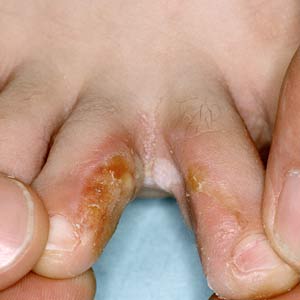Tinea Pedis (Athlete's Foot)
Tinea Pedis (Athlete's Foot)
Book Now
Tinea Pedis (Athlete's Foot)
What Are the Symptoms of Athlete's Foot?
Symptoms include dry, white scaling, thickening, cracking, and a moist appearance, particularly between the fourth and fifth toes. Intense itching and unpleasant odor may also accompany the condition. Infections in the spaces between the toes, often called "jock itch" in common parlance, may present as dry peeling or occasionally as a cheesy, white appearance.
Is Athlete's Foot Contagious?
Yes, athlete's foot is contagious. Fungal infections can spread from one area of the body to another, between people, from objects to people, and from animals to humans. The infection can spread through direct foot-to-foot contact, shared use of items like slippers, socks, shoes, or towels, or in public spaces such as showers, baths, beaches, and gyms. Additionally, fungal infection can spread to toenails through shared nail clippers or files. Moisture creates an ideal environment for fungal growth.
How Can Athlete's Foot Be Prevented?
You can prevent athlete's foot by following some simple rules: Wash your feet daily and dry between the toes thoroughly. Avoid tight shoes and socks, choose cotton socks, and change them regularly. In the summer, use antifungal powder in your shoes. Do not share nail clippers, slippers, socks, or foot towels with others. Trim your nails regularly and disinfect old shoes or treat them with antifungal powders before use. Also, be mindful of the cleanliness of swimming pools.
How Is Athlete's Foot Treated?
Treatment for athlete's foot is more effective when followed as prescribed by a dermatologist. Depending on the severity of the infection, treatment may involve topical medications (creams) or oral antifungal tablets. Treatment typically lasts for at least a month and must be followed consistently. During the treatment period, following preventive measures can enhance the success of treatment and help prevent the infection from spreading or recurring.
Make an Appointment
The best way to enjoy a treatment at our salon is to book an appointment with the desired esthetician. Fill in the form below and we will contact you to discuss your appointment.